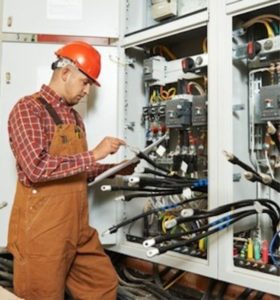 OSHA, in 29 CFR 1910.331, says only qualified persons may work on live electric circuit parts or equipment, and they “shall be capable of working safely on energized circuits and shall be familiar with the proper use of special precautionary techniques, personal protective equipment, insulating and shielding materials, and insulated tools.”
OSHA, in 29 CFR 1910.331, says only qualified persons may work on live electric circuit parts or equipment, and they “shall be capable of working safely on energized circuits and shall be familiar with the proper use of special precautionary techniques, personal protective equipment, insulating and shielding materials, and insulated tools.”
That’s pretty clear, but OSHA adds that all workers (not just electricians and the like), including contractor personnel, must be trained to recognize and avoid electrical hazards, although the degree of training depends on whether the worker is considered qualified or unqualified. Unqualified workers are not expected to work on energized electrical equipment, but they must be trained to identify and avoid electrical hazards.
There is a difference in how close qualified and unqualified workers can get to electrical equipment. NFPA 70E, the standard to which OSHA inspectors adhere, specifies the approach boundaries (limited approach, restricted approach and prohibited approach) to live parts, and prescribes the PPE and training required.
Who must be trained?
A qualified worker is defined by Article 100 of the 2008 edition of the National Electrical Code as “one who has skills and knowledge related to the construction and operation of the electrical equipment and installations and has received safety training to recognize and avoid the hazards involved.”
Note that both specific knowledge of the equipment and formal safety training are required. A person can be qualified with respect to certain equipment and methods but unqualified for others.
 Even an experienced electrician is unqualified unless he or she knows the particular equipment and has received specific safety training on the potential hazards involved. According to OSHA, some typical employees who face a higher-than-normal risk of electrical accidents and, hence, require training include blue-collar supervisors, electrical and electronic engineers, electrical and electronic technicians, electricians, industrial machine operators, material handling equipment operators, mechanics and repairers, painters, riggers and roustabouts, stationary engineers, and welders.
Even an experienced electrician is unqualified unless he or she knows the particular equipment and has received specific safety training on the potential hazards involved. According to OSHA, some typical employees who face a higher-than-normal risk of electrical accidents and, hence, require training include blue-collar supervisors, electrical and electronic engineers, electrical and electronic technicians, electricians, industrial machine operators, material handling equipment operators, mechanics and repairers, painters, riggers and roustabouts, stationary engineers, and welders.
With the exception of electricians and welders, these workers need not be trained if their work does not bring them close to exposed electric parts operating at 50 volts or more. Although this might look like a loophole, it may be of limited applicability in view of this blanket OSHA requirement: “Any other employees who may reasonably be expected to face comparable risk of injury due to electric shock or other electrical hazards must also be trained.”
So just about any employee who works anywhere near energized electrical equipment must be trained to recognize and avoid electrical hazards.


